July 05, 2024LABOUR MARKET TRENDS, JUNE 2024 June labour force survey results reflect the period from June 9 to 15, 2024.
Ages 15+ (June 2024 vs May 2024, seasonally adjusted)
Nova Scotia's seasonally adjusted employment declined by 1,700 (-0.3%) to 512,900 in June following a decline of 900 (-0.2%) to 514,600 in the previous month.
The change in employment was attributable to a decrease in full-time employment (-2,600) partially offset by an increase in part-time employment (+800). Note that changes in full-time and part-time employment can also reflect changing hours for the same job.
Nova Scotia’s labour force declined by 900 (-0.2%) to 549,000 in June 2024.
With employment falling faster than labour force, Nova Scotia's unemployment rate rose 0.2 percentage points to 6.6% in June 2024.
Nova Scotia's labour force participation rate declined 0.3 percentage points to 61.7% and the employment rate was down 0.3 percentage points to 57.7% in June 2024.
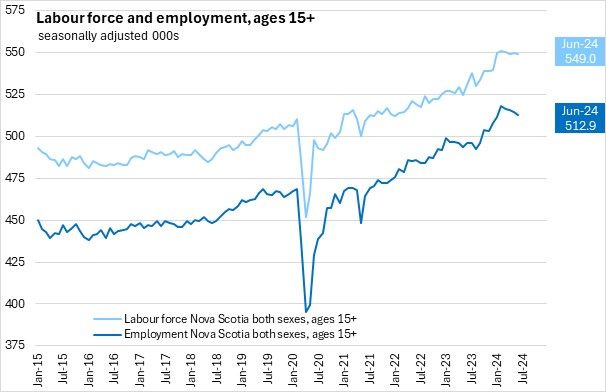
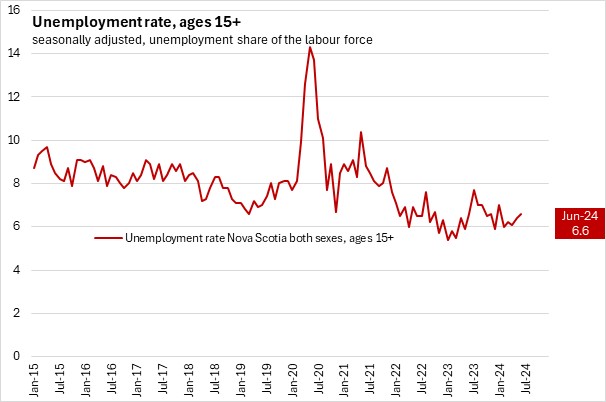
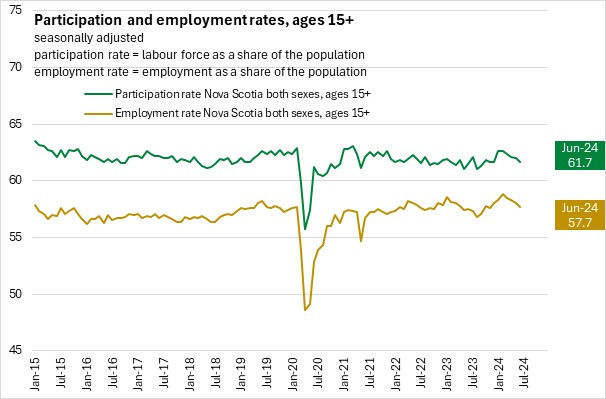
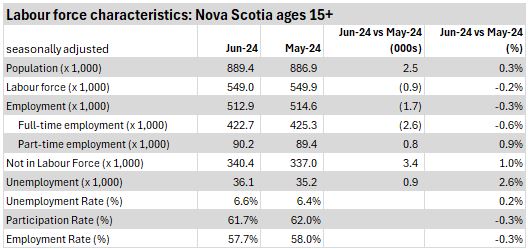
Ages 15+ (June 2024 vs June 2023, seasonally adjusted)
Compared with June 2023, Nova Scotia's population over the age of 15 increased by 26,800 (+3.1%), while the labour force grew by 18,200 (+3.4%), and employment increased by 17,100 (+3.4%). The unemployment rate was unchanged while the participation rate was up 0.2 percentage points and the employment rate up 0.2 percentage points.
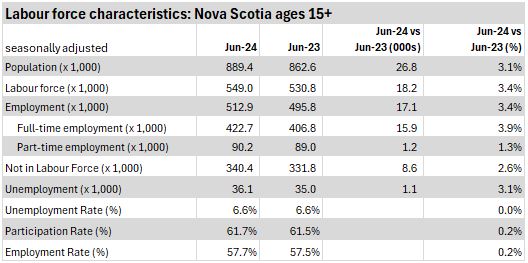
Ages 15+ (January-June 2024 vs January-June 2023, seasonally adjusted)
Compared with January-June 2023, Nova Scotia's population over the age of 15 increased by 26,800 (+3.1%), while the labour force grew by 22,500 (+4.3%), and employment increased by 18,700 (+3.8%). The unemployment rate was up 0.4 percentage points with the participation rate up 0.7 percentage points and the employment rate up 0.4 percentage points.
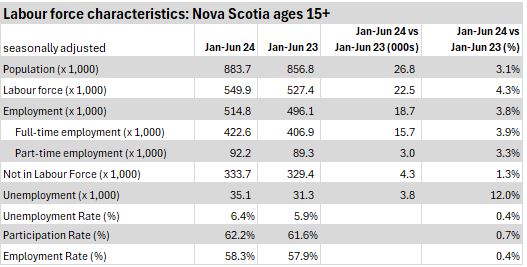
Note: Year-to-date estimates are calculated as averages of monthly data and rounded to the nearest tenth. Year-to-date changes in the table are also rounded to the nearest tenth.
Age Cohorts (June 2024 vs May 2024, seasonally adjusted)
Among youth (ages 15-24), employment declined by 1,700 (-2.4%) while the labour force fell by 2,000 (-2.5%). With a faster decline in labour force than employment, the youth unemployment rate declined 0.2 percentage points to 12.7% in June. The youth participation rate declined 2.4 percentage points to 64.8% and the youth employment rate was down 2.0 percentage points to 56.6%.
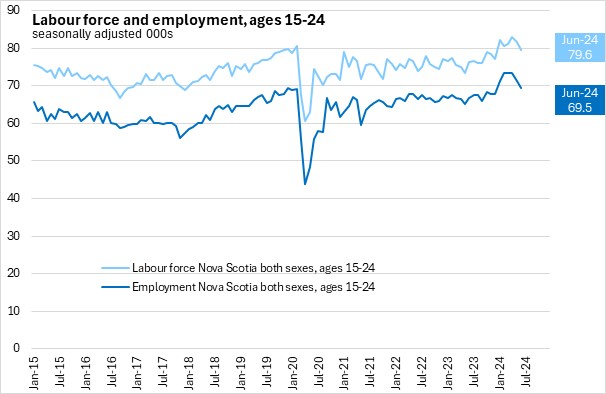
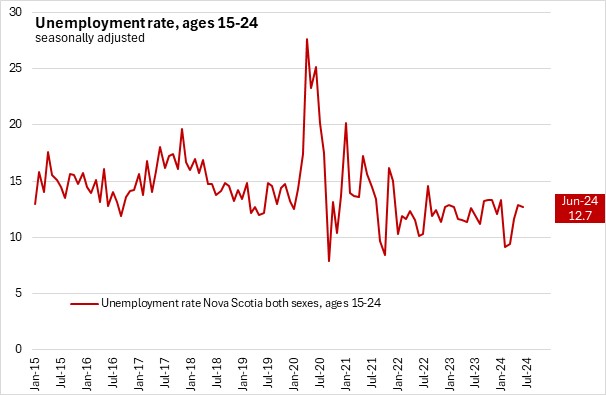
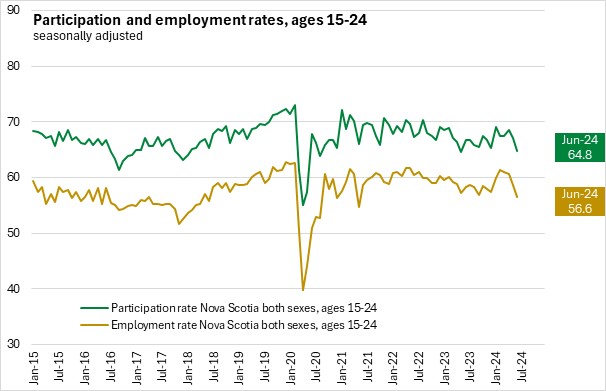
The population aged 25-54 makes up the largest part of the labour force. In the core age group, employment was up 1,500 (+0.5%) while the labour force rose by 1,400 (+0.4%). With employment rising in step with the labour force, the core aged unemployment rate was unchanged at 5.8% in June 2024. The core aged participation rate edged up 0.1 percentage point to 87.5% and the core aged employment rate rose 0.2 percentage points to 82.5%.
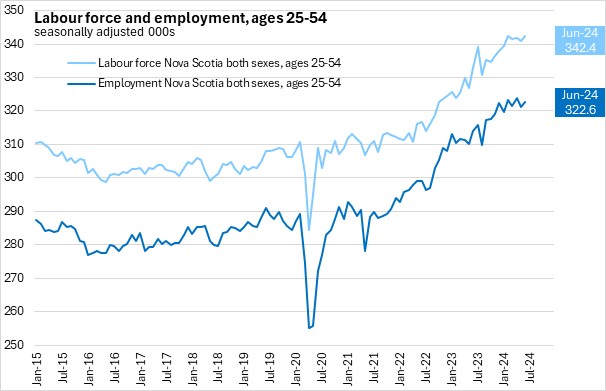
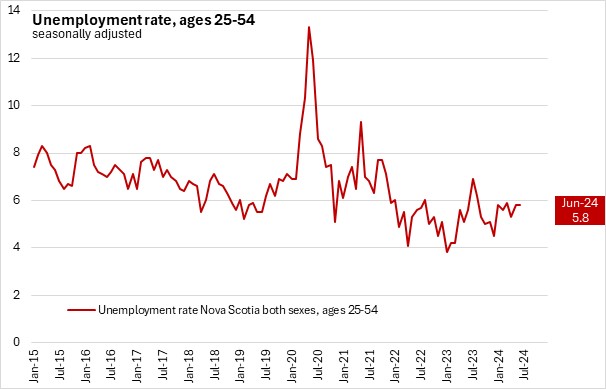
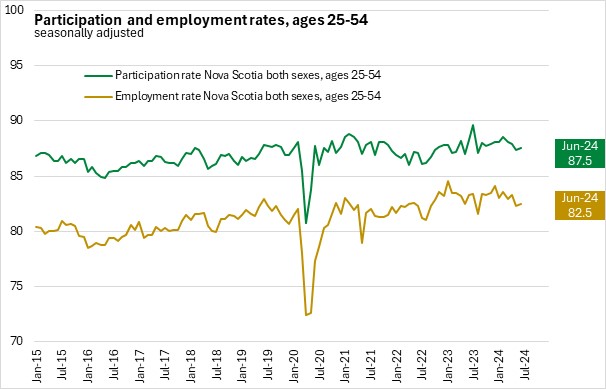
Older workers (aged 55+) reported the labour force declined by 200 (-0.2%) while employment declined by 1,600 (-1.3%). With employment falling faster than the labour force, the older worker unemployment rate rose 1.1 percentage points to 5.0%. The older worker participation rate edged down 0.1 percentage point to 33.8% and the employment rate for older workers declined 0.4 percentage points to 32.2%.
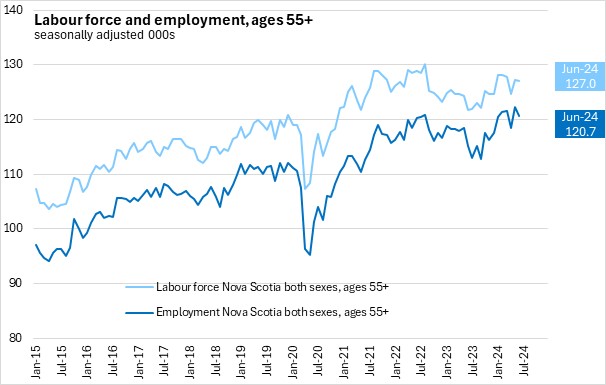
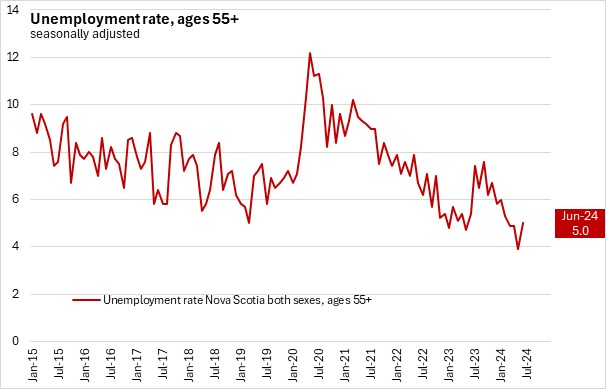
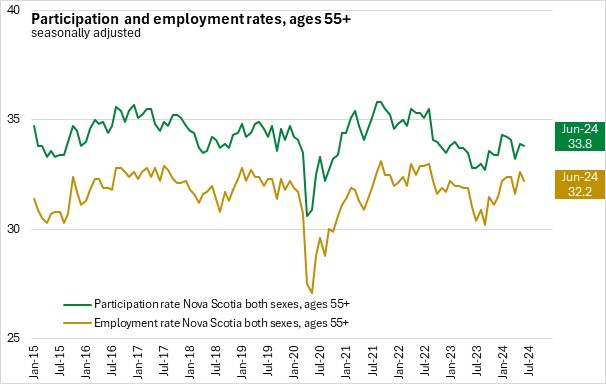
Males and Females (Ages 15+, June 2024 vs May 2024, seasonally adjusted)
Monthly employment declined 700 (-0.3%) for males while the labour force declined by 100 (-0.04%). With a smaller decline in labour force than employment, the male unemployment rate rose 0.2 percentage points to 6.8% in June. The male participation rate declined 0.2 percentage points to 64.4% and the male employment rate declined 0.4 percentage points to 60.0%.
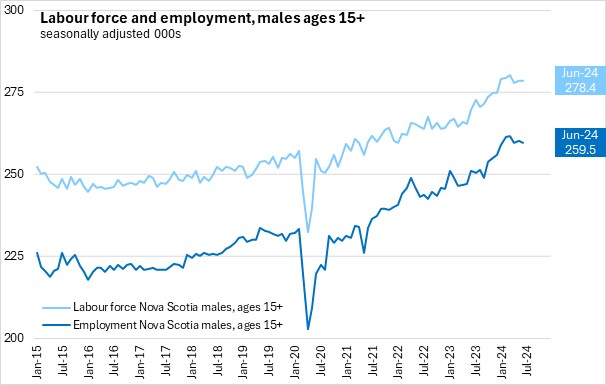
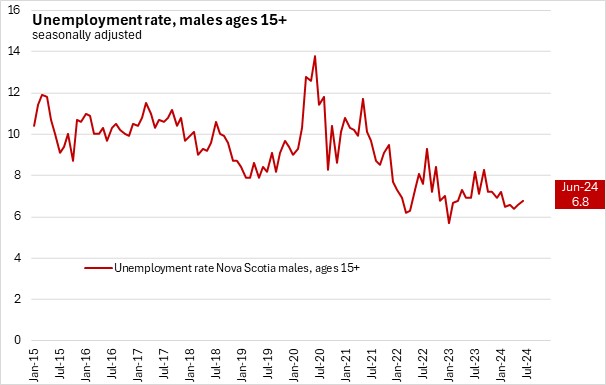
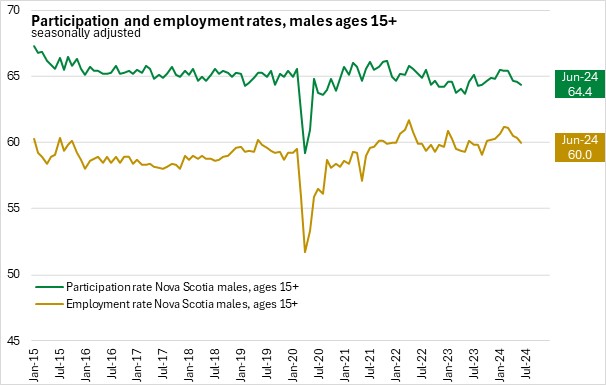
Females reported a decline in employment of 1,100 (-0.4%) while the labour force declined by 800 (-0.3%). With labour force declining at a slower pace than employment, the female unemployment rate edged up 0.1 percentage point to 6.4% in June. The female participation rate declined 0.3 percentage points to 59.2% and the female employment rate declined 0.4 percentage points to 55.4%.
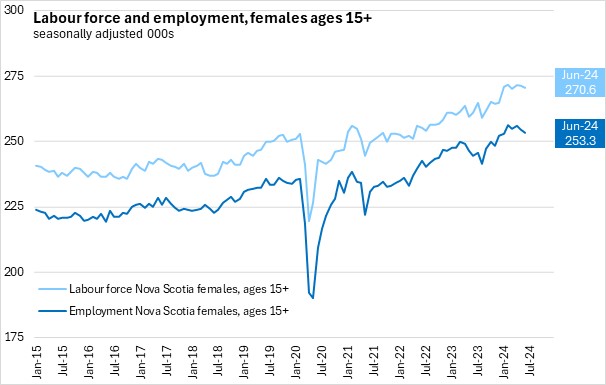
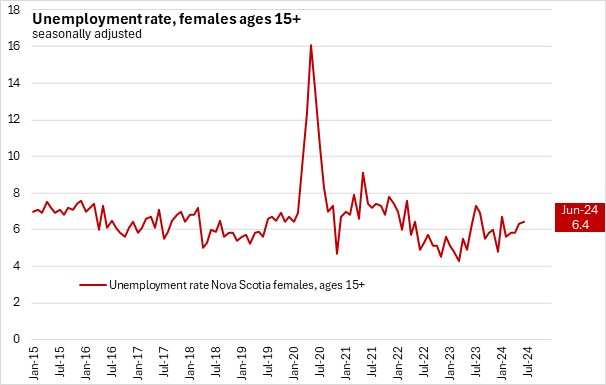
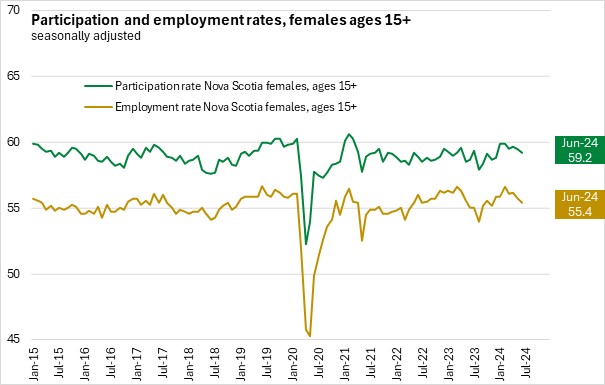
June's decline in labour force and employment was primarily due to declines among youth and older workers, partially offset by increases for core-aged workers. The labour force decline was concentrated among females, while both males and females saw employment declines. Males saw a larger increase in unemployment in June.
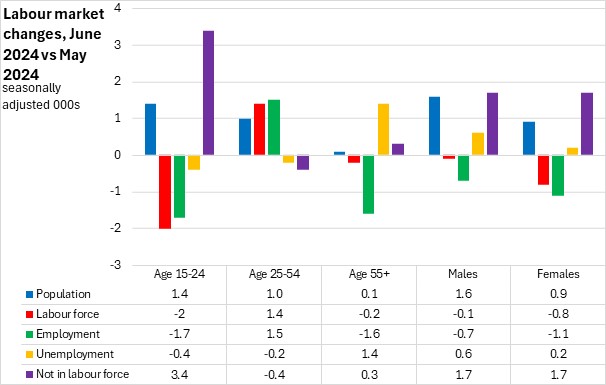
Age and sex cohorts (June 2024 vs June 2023, seasonally adjusted)
Compared with June 2023, labour force and employment growth was highest among core aged workers (whose population has also grown the most over this period). The next highest labour force and employment gains were among older workers (55+). Only the older cohort had an increase in employment that outpaced labour force gains on a year-over-year basis. Female labour force and employment have increased more than for males when compared to June 2023. Females saw a larger year-over-year increase in unemployment compared to males.
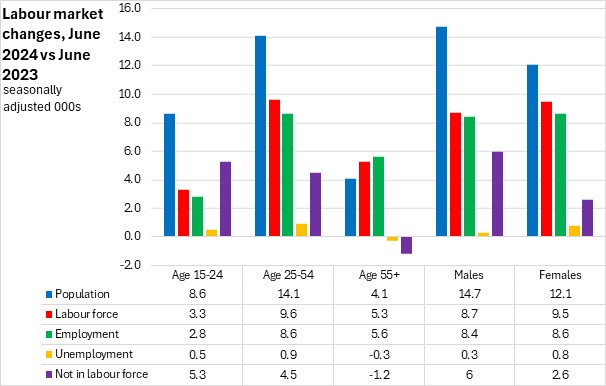
Age and sex cohorts (January-June 2024 vs January-June 2023, seasonally adjusted)
Compared with January-June 2023, labour force and employment growth was highest among core-aged workers (whose population is also growing more than others). Labour force growth outpaced employment growth for core-aged workers, and, to a lesser extent, youth workers. Older workers saw a larger increase in employment than labour force. Core-aged workers had a notable increase in unemployment compard to youth and older workers as labour force growth outpaced employment growth. Population, labour force, and employment have increased more for males than females compared to January-June 2023. Females have seen a higher increase in unemployment compared to males for the first six months of the year.
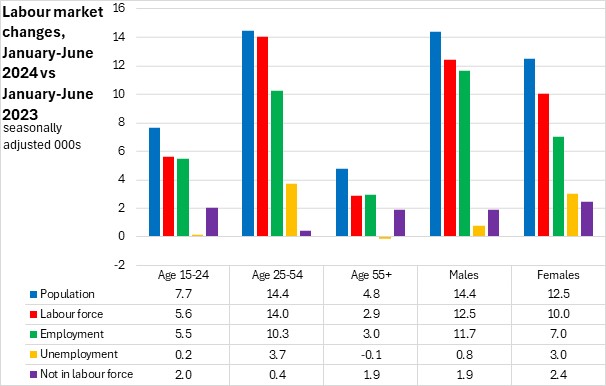
Class of Worker and Industry (June 2024 vs May 2024, seasonally adjusted)
The June 2024 employment change primarily reflected a decline in private sector employment (-3,500, -1.1%) with a smaller decline in self-employed (-700, -1.4%). There was an increase for public sector employment (+2,500, +1.9%) in June.
Classified by industry, the largest employment decline from May to June was in professional/technical services followed by finance/insurance/real estate and personal/repair services. The largest increase was in health/social assistance.
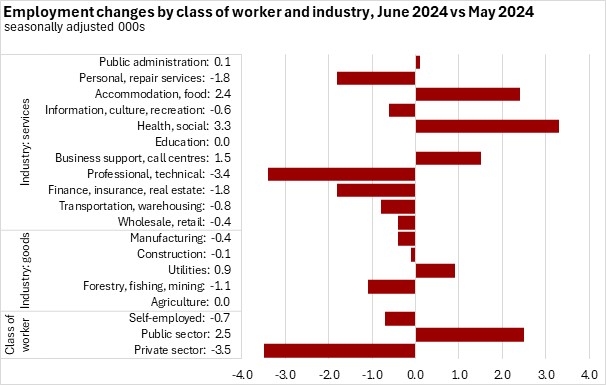
Class of Worker and Industry (June 2024 vs June 2023, seasonally adjusted)
Compared to June 2023, there were gains in employment for private sector workers (+6,300 or +2.0%) and public sector workers (+18,500 or +15.6%), and a decline in self-employed (-7,700 or -13.1%).
Over the last 12 months, employment was up in most sectors with the largest gains in education, accommodation/food, and public administration. The largest decline was reported for professional/technical services.
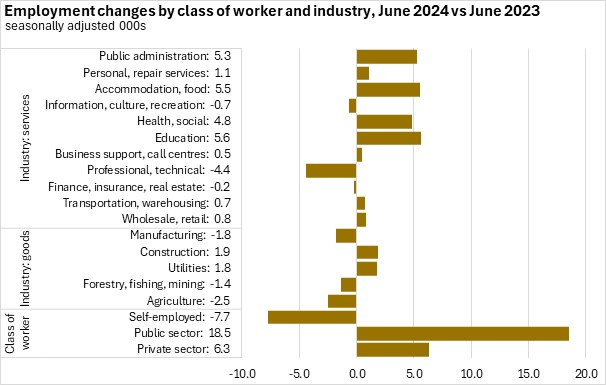
Class of Worker and Industry (January-June 2024 vs January-June 2023, seasonally adjusted)
Compared to January-June 2023, gains were strongest for private sector workers (+12,600 or +4.0%) followed by public sector workers (+11,900 or +9.9%). The number of self employed declined (-5,700 or -9.9%) in January-June 2024.
Gains in employment were strongest in education and wholesale/retail while the largest declines were in professional/technical services and agriculture in the first six months of 2024.

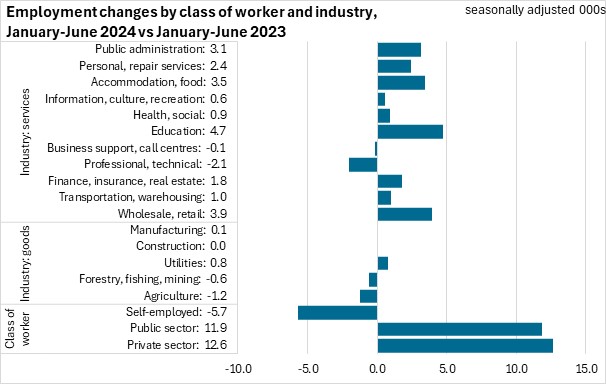
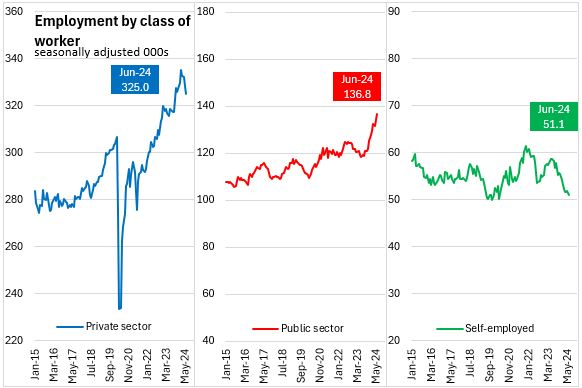
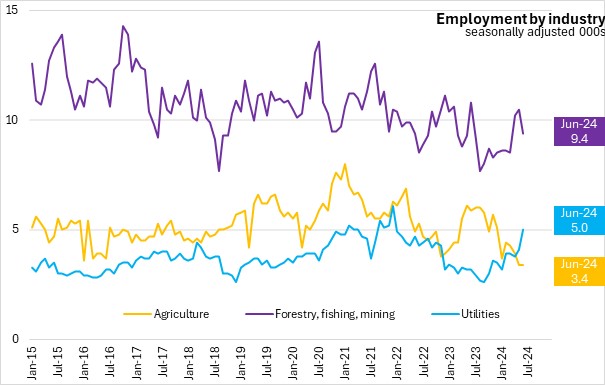
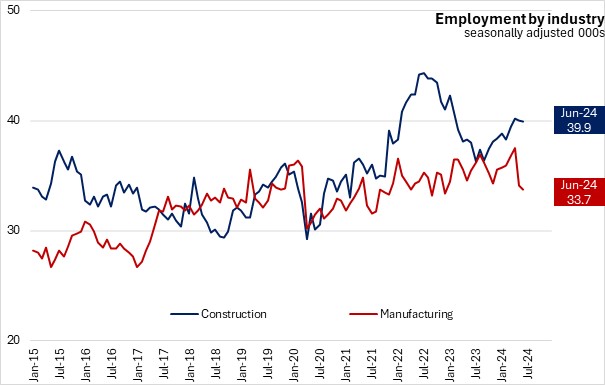
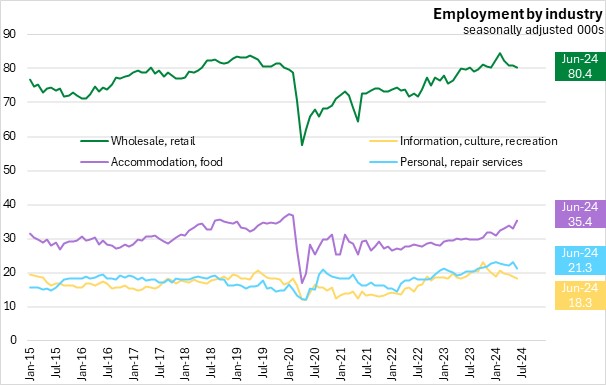
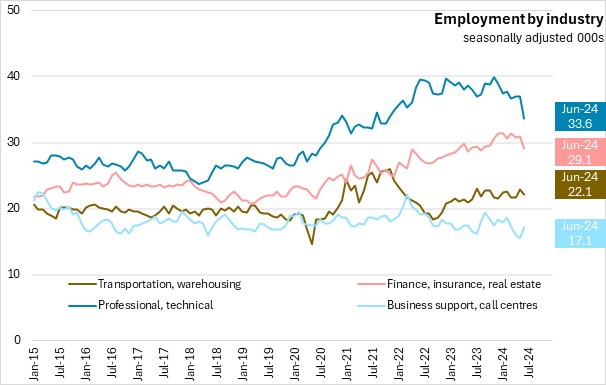
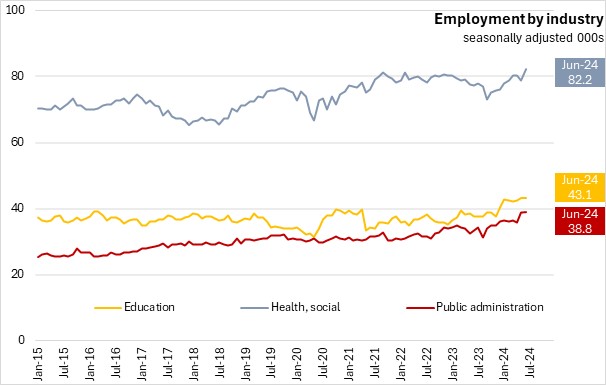
Hours worked and employment (June 2024, unadjusted)
Compared to the provincial average, a larger share of workers in forestry/fishing/mining, agriculture, construction, manufacturing, transportation/warehousing, professional/technical, and education worked more than 40 hours per week in June 2024.
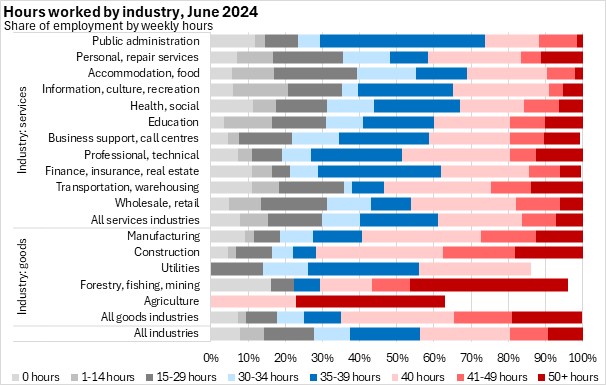
Note that some data on those working few hours in utilities, forestry/fishing/mining and agriculture were suppressed.
Average weekly earnings (unadjusted, both full time and part time, June 2024 vs June 2023)
Average weekly earnings increased by 7.7% from June 2023 to June 2024. The fastest gains in average weekly earnings were in utilities, personal/repair, manufacturing and health/social assistance. Only forestry/fishing/mining and information/culture/recreation reported lower earnings compared to June 2023.
The increase in Nova Scotia's all items consumer price index was 3.7% from May 2023 to May 2024.
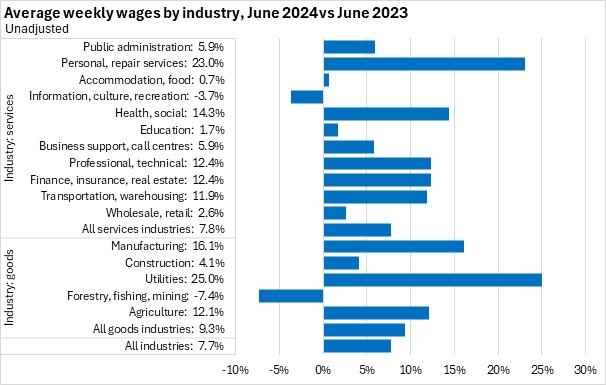
Average weekly earnings across all employees were $1,148.63 in June 2024. The highest average weekly earnings (both full and part time employees) were reported in professional/technical, utilities, public administration and forestry/fishing/mining. The lowest average weekly earnings were in accommodation/food services, wholesale/retail trade and business support (including call centres).
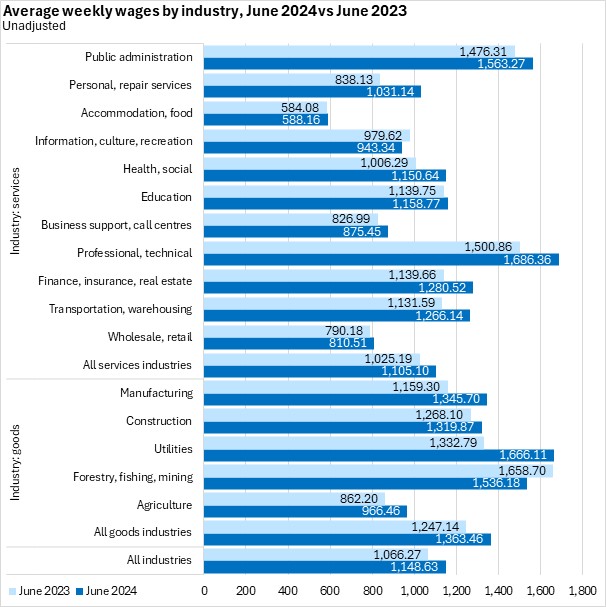
Average weekly earnings (unadjusted, both full time and part time, January-June 2024 vs January-June 2023)
Average weekly earnings increased 6.5% in the first six months of 2024 compared to the same period of 2023. The fastest gains in average weekly earnings were in utilities, manufacturing, professional/technical services, and transportation/warehousing. Business support (including call centres) and agriculture registered the fastest declines in average weekly earnings in January-June 2024.
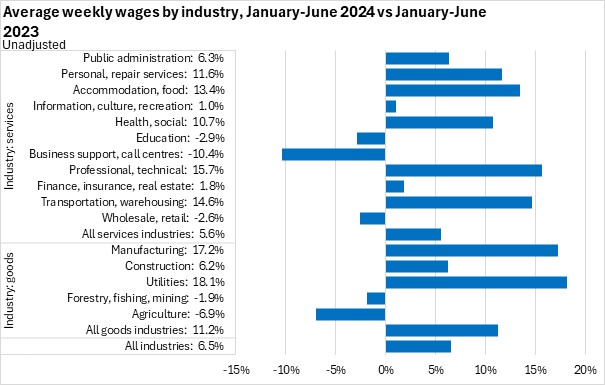
Average weekly earnings in the first six months of 2024 were highest in utilities, professional/technical services, and public administration. The lowest average weekly earnings were in accommodation/food services, wholesale/retail trade and business support services (including call centres) in January-June 2024.
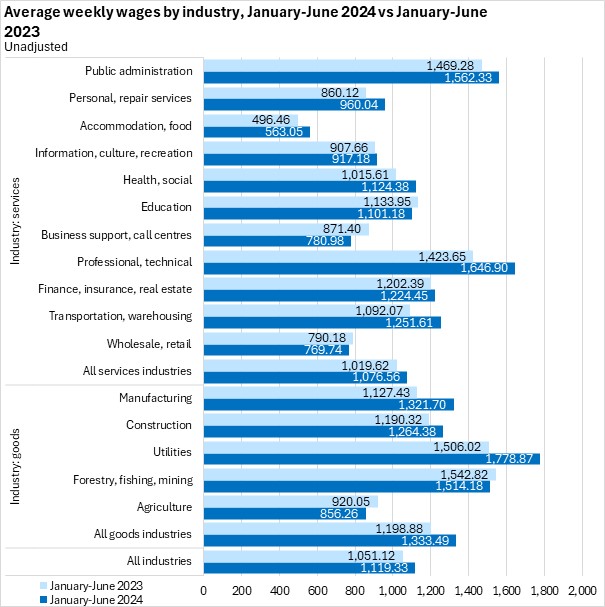
Regions (June 2024 vs June 2023, unadjusted 3 month moving average)
Compared with June 2023, labour force and employment increases were concentrated in Halifax. Cape Breton reported faster growth in employment than labour force, resulting in lower unemployment compared to one year ago. The North Shore saw labour force fall faster than employment leading to lower unemployment. North Shore population growth with declines in labour force and employment also led to growth in those not in the labour force. Annapolis Valley reported strong population growth and smaller growth in labour force and employment, leading to increases in unemployment and persons not in the labour force. Southern Nova Scotia reported declining employment and labour force, resulting in higher unemployment.
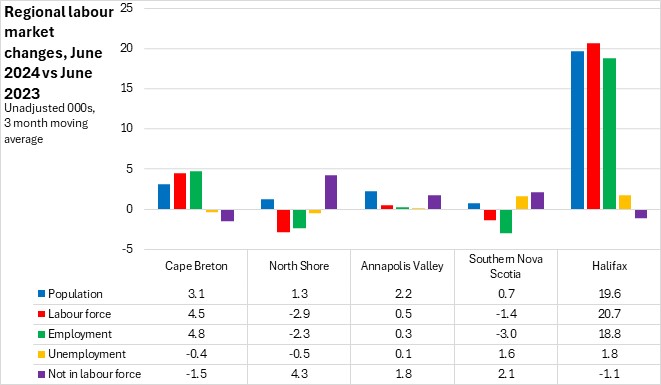
Unemployment rates were up in Annapolis Valley, Southern Nova Scotia and Halifax while they declined in Cape Breton and the North Shore. Participation and employment rates were up in Halifax and Cape Breton and down for all other regions.
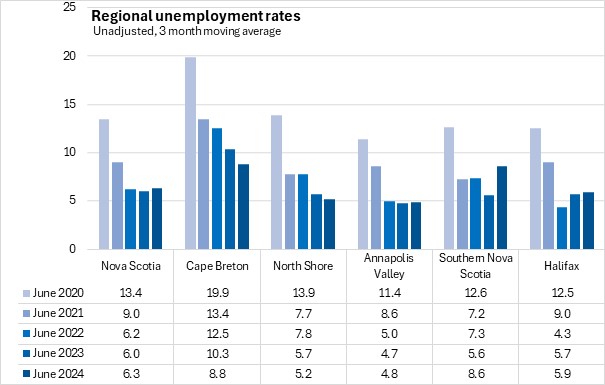
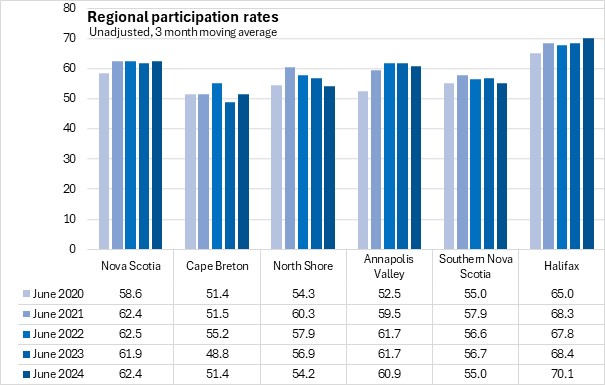
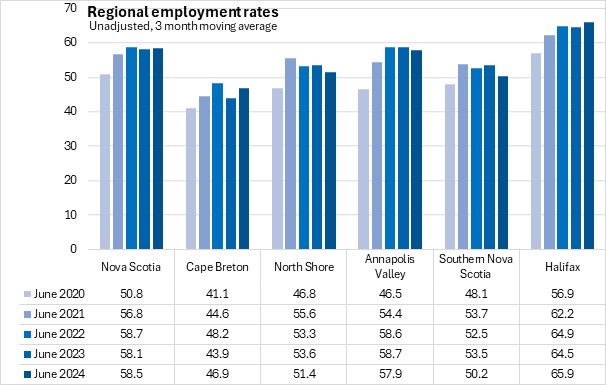
Regions (January-June 2024 vs January-June 2023, unadjusted 3 month moving average)
Compared with the first six months of 2023, all regions except Southern Nova Scotia reported higher labour force and higher employment. Labour force gains outpaced employment growth, resulting in higher unemployment in every region.
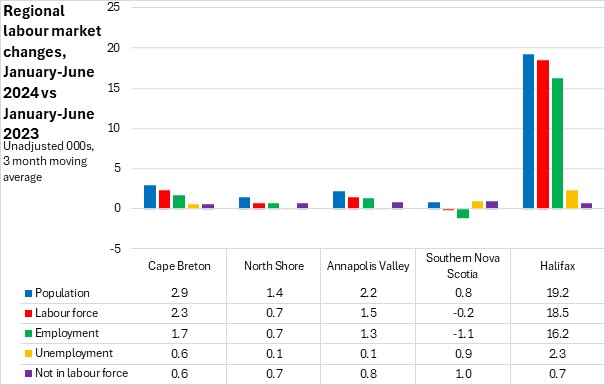
Provincial Comparisons (seasonally adjusted)
Canada's labour force was up 0.2% from May with seven provinces reporting increases in labour force in June 2024, with the largest percentage increase in Prince Edward Island. The largest decline in labour force was in British Columbia.
Compared with June 2023, the national labour force was up 2.8%. Prince Edward Island reported the fastest increase while slowest growth was in Quebec.
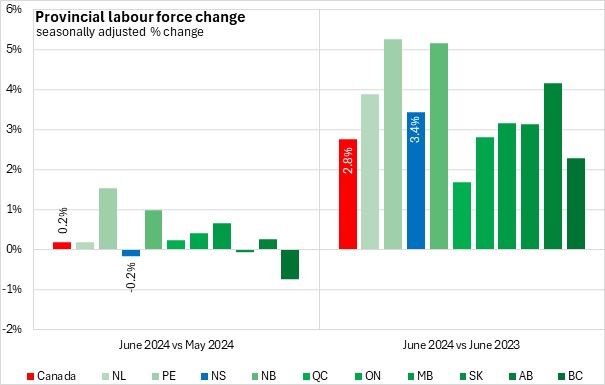
Canada's employment was virtually unchanged from May to April (-1,400). Seven provinces reported higher employment in June, led by Newfoundland and Labrador. Compared with June 2023, Nova Scotia's employment was up 3.4%, faster than the national gain of 1.7%. The fastest year-over-year gain was in Prince Edward Island and the slowest growth was in Quebec over this period.
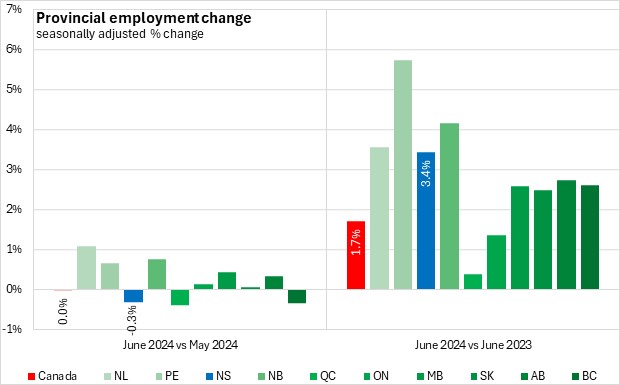
The national unemployment rate was 6.4% in June 2024, up from 5.4% in June 2023. Manitoba had the lowest unemployment rate while Newfoundland and Labrador reported the highest unemployment rate in June 2024.
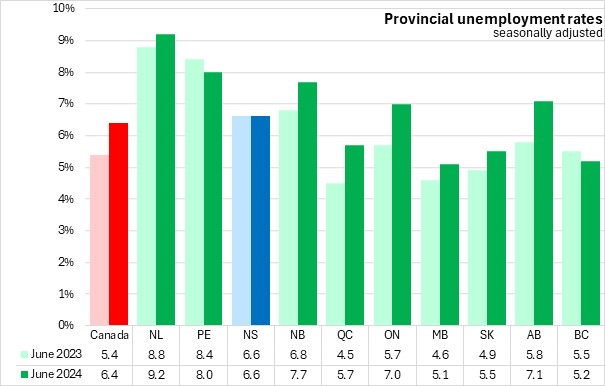
The national participation rate was 65.3% in June 2024. The highest participation rate was in Alberta while the lowest was in Newfoundland and Labrador.
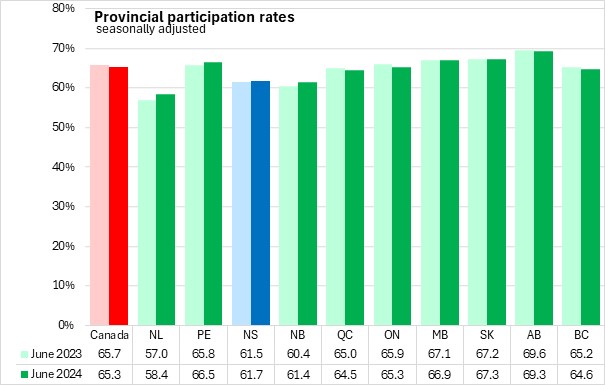
The national employment rate was 61.1% in June 2024. Alberta reported the highest employment rate while Newfoundland and Labrador reported the lowest.
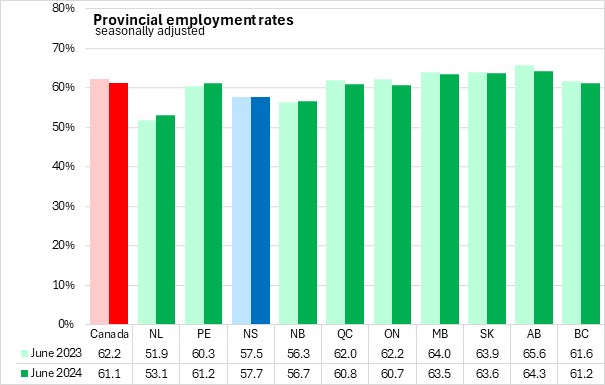
Census Metropolitan Areas (June 2024, seasonally adjusted 3 month moving average)
The Halifax unemployment rate was 5.8% in the seasonally adjusted June 2024 three month moving average. Outside of Halifax the unemployment rate was 7.1%. In central and western provinces, unemployment rates in Census Metropolitan Areas are similar to or higher than unemployment rates outside CMAs. In the Atlantic Provinces unemployment rates are typically higher outside CMAs.
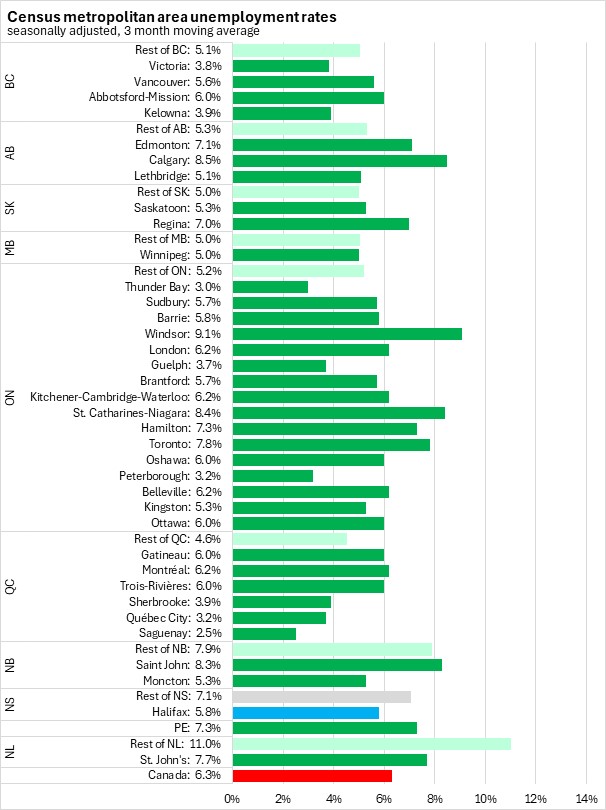
Halifax's participation rate was 69.6% in the seasonally adjusted June 2024 three month moving average, while participation rates were 54.9% across the rest of the province.
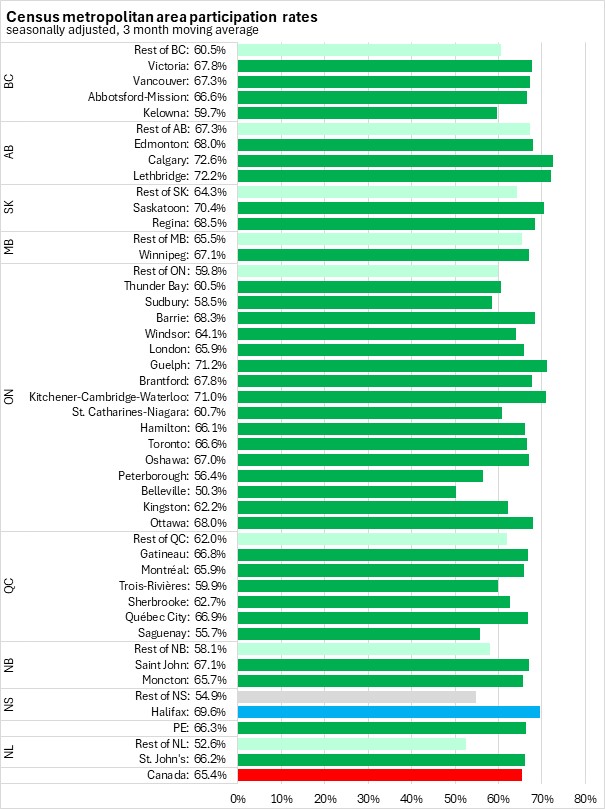
Halifax reported an employment rate of 65.6% in the seasonally adjusted June 2024 three month moving average, while the employment rate was 51.0% outside the city.
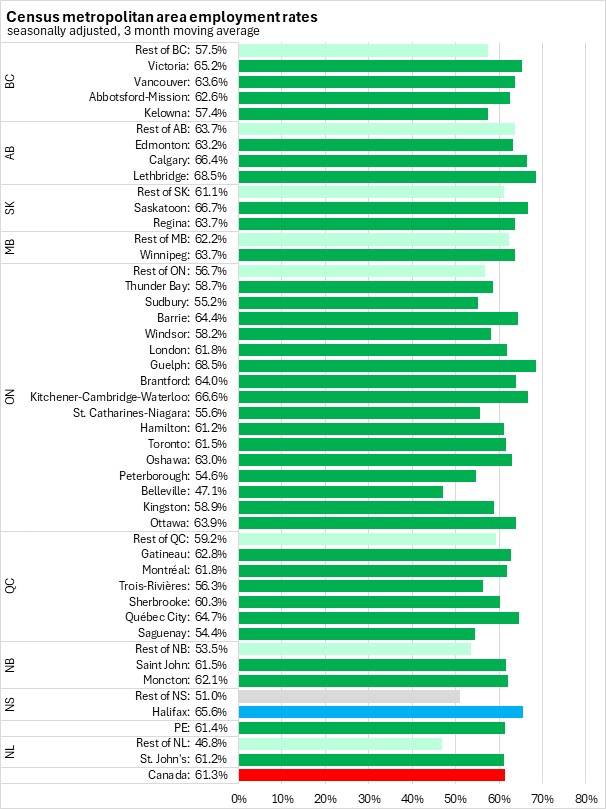
Sources: Statistics Canada. Table 14-10-0036-01 Actual hours worked by industry, monthly, unadjusted for seasonality; Table 14-10-0063-01 Employee wages by industry, monthly, unadjusted for seasonality; Table 14-10-0287-01 Labour force characteristics, monthly, seasonally adjusted and trend-cycle, last 5 months; Table 14-10-0380-01 Labour force characteristics, three-month moving average, seasonally adjusted; Table 14-10-0387-01 Labour force characteristics, three-month moving average, unadjusted for seasonality, last 5 months; Table 14-10-0355-01 Employment by industry, monthly, seasonally adjusted and unadjusted, and trend-cycle, last 5 months (x 1,000); Table 14-10-0288-01 Employment by class of worker, monthly, seasonally adjusted and unadjusted, last 5 months (x 1,000); Table: 14-10-0380-02 Labour force characteristics, three month moving average, seasonally adjusted (x 1,000)